New generations are the future we believe in; focus our work on kids has to be one of our priority. Do they know what coexistence means? What ideas do they have about it? What can we do to improve their knowledge and to make them treasure the right information?
We made a survey to understand what kids know about large carnivore in the Alps. In this article I report the results with some brief thoughts about them.
270 kids agreed to fill in the survey, most of them from Trentino Alto Adige, an area where both wolves and bears are present. The reason why we had a lot of feedbacks from Trentino Alto Adige is because is where I live and most of my contacts in Italy are here.
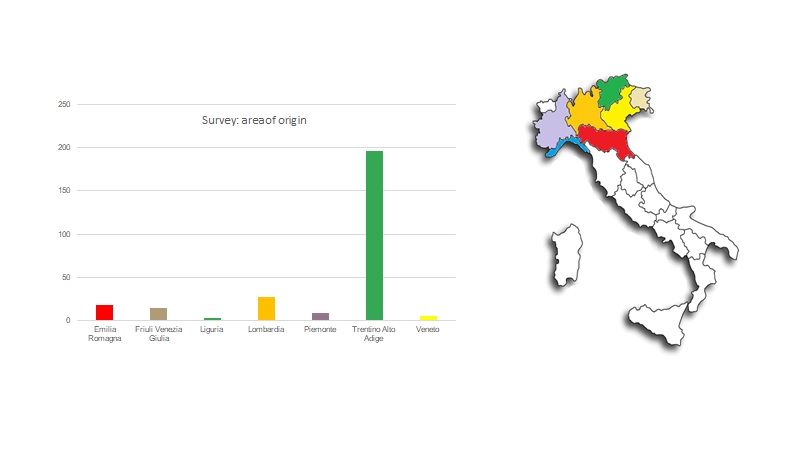
I focused my attention on primary and middle school because we think they are old enough to understand this kind of issue but they are not to old to be influenced by media or adults’ opinions. It’s important they can develop they own ideas based on objective and scientific information.
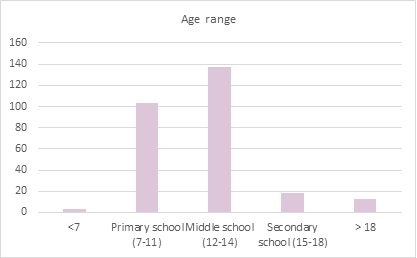
First of all, I wanted to test their knowledge about the situation in Italy. Do they know there are bear and wolves in Italy?
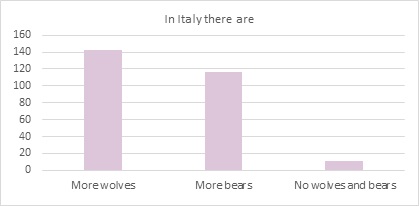
So far so good, only 11 out of 270 think there are no bears and wolves in Italy. Unfortunately, all of them are from areas where they are both present (Trentino Alto Adige, Friuli Venezia Giulia and Lombardia). 142 out of 270 were correct. Good job!
The first interesting result is a about the following question:
“Did you talk about Large Carnivore at school, in class or in other contest such as museums?”
Unfortunately, 34% of the answers were “I don’t remember”.
“Huston. We have a problem!”. Why do they not remember?
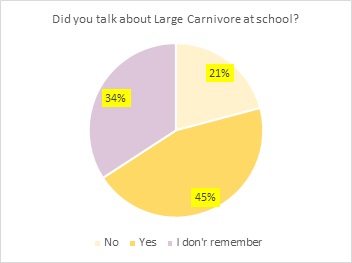
When we project an activity, the most important question we have to ask ourselves is: “What can I do to leave a mark?” I don’t want them to remember everything, that’s impossible. I want them to have fun, to learn simple but effective concepts in a funny and interactive way. They have to enjoy what they are doing. My mission is not to be boring, no matter what I’m talking about. Learning by doing is the right strategy. We have to give them few and brief information that they can elaborate drawing, playing, singing, acting, building and touching. Provide them the instruments to get to what we want to communicate should be our goals. Words don’t last, good memories do.

This data is even more worrying if we analyze responses from Trentino Alto Adige. Many activities and initiatives have been carried on in this region, due to bear/wolf-human coexistence issues. The fact that 30% of them are “don’t know” should be an alarm to improve communication and make it more effective.
The next questions were to test whether misconceptions and prejudice are still present in the population.
Of course, they are!
I asked to write down 3 words that recall bears and other 3 to recall wolves. I choose the most frequent ones and put them in two different world cloud, one for bears and one for wolfs (click here for the complete list)
Here what I found out about wolves:
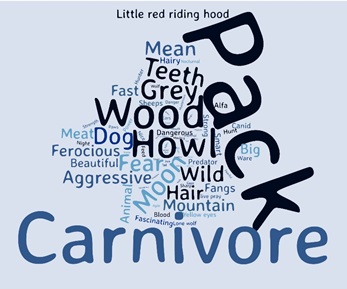
As you can see from the wordcloud, the most frequent word is “Pack” followed by “Carnivore”, “Wood” and “Howl”. So far so good, since they are all objective words that can perfectly mach with wolves. Unfortunately the words “Mean”, “Aggressive”, “Ferocious”, “Fear”, “Fangs” are also well rapresented. Of course there are also many other positive words but the fact that most of us associated wolves with fear and danger is something we cannot understimate. Wolves rarely attack people, specially in the occidental world (since year 2000 we just had 2 possible attack in Europe (Poland) and about 10 in Nord America) so why do we still fear them so much? There are many other danger that could scare us and that we could worry about. So why wolves? Probably we are not doing enough to defeat the misconconception linked to this animal. Once again we need a right scientific education. It’s ok to be scared, it’s important to know that wild animals are not poppies and it’s foundamental to teach the new generation how to coexist with them. Getting to know deeply the wolves biology, ecology and etology could help people to have a right point of view and to rationalize the issue. No less important is to let them know that there are ways to prevent the most common problems such as predatory behavior on domestic animals. It is something they probably don’t deal with directly, but it’s something they heard about and they may experience in the future. If nature changes we have to adapt, we have the instruments to coexist with it and they need to know it.
Different feedback came about bear. I reported here the first 10 most choosen words. We steel read “Aggressive” and “Dangerous” and other words such as “Mean” and “Brutal” have been mentioned. However, the most interesting thing is that for bears in particular have been choosen a lot of pet name that usually we do not associate to wild animals. Contrary to the wolf, bear is seen as a funny and goofy pet. Cartoon, books and moovie teach us that bears are friendly, goofy and funny. On one hand this could help us to protect them and to learn more about them but, on the other hand, this could lead us to a wrong perception about what they really are. They are bears, wild animals. They are usually not aggressive but they could be in certain circumstances. We have to teach people that wild animals cannot be seen as pets, we have to tell people how to behave so that both humans and bears can coexist.
Here you can see the first 10 most written words about bears and following a wordcloud with “pet name” words that have been mostly used.
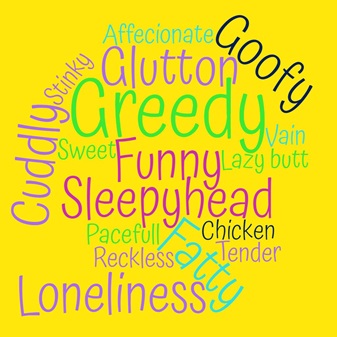
The next quiestion was to test basic knowledge about bears.
“What brown bears eat?” Here the answers:
This is apparently a simple question, but it could help us to understand how much people know about these animals.
Brown bears are omnivorous, eating mostly a mixed diet of plants, berries, insencts and small mammals (more than 60% of the diet): they are very skilled at finding a big variaty food. They sometimes can prey on vulnerable animals or directly on carcasses. Most important thing: they don’t eat humans!! Most people thinks that an animal that feeds on meat is dangerous for us because we could be its pray. It doesn’t work like that. Communicate that animals “don’t like” us, fear us and most of the time avoid us is foundamental to start seeing them as they really are.

As we can see from the graph, the good news is that only 8% of the answer were “only meat” but most people still thinking that bears feed mostly on meat (59%) instead of mostly on plants (33%).
It would be interesting to investigate more about this belief and to see how much it affects the sense of danger linked to these animals.
One of the problem could be that the words “carnivore” and “carnivorous” always create confusion, specially in Italy were the two words are exatly the same: “carnivoro”. Next graph could proove this theory.
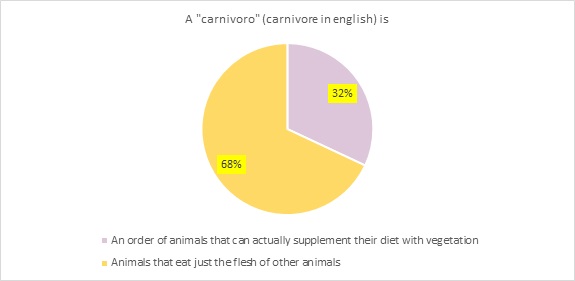
A carnivore is an animal or plant that eats the flesh of animals. Most (but not all) carnivorous animals are also members of the Carnivora, a specific mammal order. More importantly not all members of the Carnivora order are carnivorous. I know it sounds like a tongue twister but it’s a very important notion that, in my opinion could lead to wrong ideas. The probles is exaggerated in Italy because the two words look Let’s work on that too!
Do we have to keep communicate? Yes, we do. My last question is pretty much comforting. More than 80% of the answers were in favor of learning more about Large Carnivore and this is what we want to do. Keep telling people that communication is the way to improve our confort, to reduce conflicts and to see what’s going on in a clear and objective way.
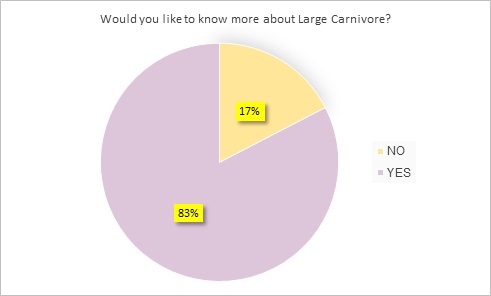
“Knowing our planet is a step towards protecting it” once Jacques Yves Cousteau said. And I want to add “towards a good coexistence with animals and environment we are used to fear”.

